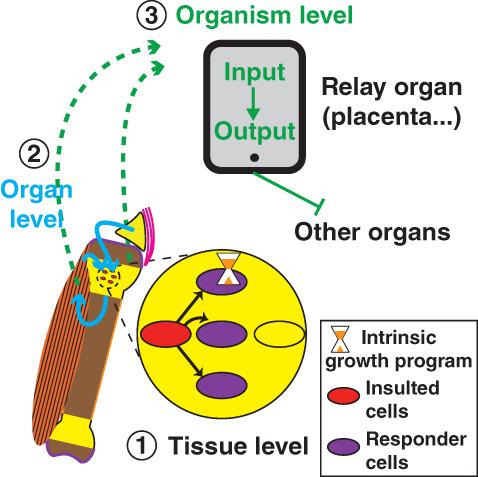当前位置:
X-MOL 学术
›
WIREs Mech. Dis.
›
论文详情
Our official English website, www.x-mol.net, welcomes your
feedback! (Note: you will need to create a separate account there.)
Integrating levels of bone growth control: From stem cells to body proportions.
WIREs Mechanisms of Disease ( IF 4.6 ) Pub Date : 2020-05-20 , DOI: 10.1002/wdev.384 Brett J Kagan 1 , Alberto Rosello-Diez 1
WIREs Mechanisms of Disease ( IF 4.6 ) Pub Date : 2020-05-20 , DOI: 10.1002/wdev.384 Brett J Kagan 1 , Alberto Rosello-Diez 1
Affiliation

|
The study of the mechanisms controlling organ size during development and regeneration is critical to understanding how complex life arises from cooperating single cells. Long bones are powerful models in this regard, as their size depends on a scaffold made from another tissue (cartilage, composed of chondrocytes), and both tissues interact during the growth period. Investigating long bone growth offers a valuable window into the processes that integrate internal and external cues to yield finely controlled size of organs. Within the cellular and molecular pathways that control bone growth, the regulation of stem‐cell renewal, along with amplification and differentiation of their progeny, are key to understanding normal and perturbed long‐bone development. The phenomenon of “catch‐up” growth–where cellular hyperproliferation occurs following injury to restore a normal growth trajectory–reveals key aspects of this regulation, such as the fact that bone growth is target‐seeking. The control mechanisms that lead to this behavior are either bottom‐up or top‐down, and the interaction between these modes is likely critical to achieve a highly nuanced, yet flexible, degree of control. The role of cartilage‐intrinsic mechanisms has been well studied, establishing a very solid groundwork for this field. However, addressing the unanswered questions of bone growth arguably requires new hypotheses and approaches. Future research could for example address to what extent extrinsic signals and cells, as well as communication with other tissues, modulate intra‐limb and inter‐organ growth coordination.
中文翻译:

骨骼生长控制的整合水平:从干细胞到身体比例。
研究发育和再生过程中控制器官大小的机制对于理解复杂生命如何从合作的单细胞中产生至关重要。在这方面,长骨是强大的模型,因为它们的大小取决于由另一种组织(软骨,由软骨细胞组成)制成的支架,并且两种组织在生长期相互作用。研究长骨生长为了解整合内部和外部线索以产生精细控制的器官大小的过程提供了宝贵的窗口。在控制骨骼生长的细胞和分子途径中,干细胞更新的调节及其后代的扩增和分化是理解正常和受干扰的长骨发育的关键。“追赶”生长现象——在损伤后发生细胞过度增殖以恢复正常生长轨迹——揭示了该调节的关键方面,例如骨骼生长是寻求目标的事实。导致这种行为的控制机制要么是自下而上的,要么是自上而下的,这些模式之间的交互对于实现高度细微但灵活的控制程度可能至关重要。软骨内在机制的作用已经得到很好的研究,为该领域奠定了非常坚实的基础。然而,解决骨骼生长的悬而未决的问题可以说需要新的假设和方法。例如,未来的研究可以解决外在信号和细胞以及与其他组织的交流在多大程度上调节肢体内和器官间的生长协调。
更新日期:2020-05-20
中文翻译:

骨骼生长控制的整合水平:从干细胞到身体比例。
研究发育和再生过程中控制器官大小的机制对于理解复杂生命如何从合作的单细胞中产生至关重要。在这方面,长骨是强大的模型,因为它们的大小取决于由另一种组织(软骨,由软骨细胞组成)制成的支架,并且两种组织在生长期相互作用。研究长骨生长为了解整合内部和外部线索以产生精细控制的器官大小的过程提供了宝贵的窗口。在控制骨骼生长的细胞和分子途径中,干细胞更新的调节及其后代的扩增和分化是理解正常和受干扰的长骨发育的关键。“追赶”生长现象——在损伤后发生细胞过度增殖以恢复正常生长轨迹——揭示了该调节的关键方面,例如骨骼生长是寻求目标的事实。导致这种行为的控制机制要么是自下而上的,要么是自上而下的,这些模式之间的交互对于实现高度细微但灵活的控制程度可能至关重要。软骨内在机制的作用已经得到很好的研究,为该领域奠定了非常坚实的基础。然而,解决骨骼生长的悬而未决的问题可以说需要新的假设和方法。例如,未来的研究可以解决外在信号和细胞以及与其他组织的交流在多大程度上调节肢体内和器官间的生长协调。











































 京公网安备 11010802027423号
京公网安备 11010802027423号